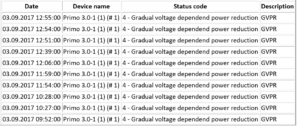Does your solar inverter come up with messages similar to this?
If so, it is usually not an inverter fault, but instead the inverter is reporting what is happening on the grid (the power from the street).
Your inverter is reporting to you a problem that you are probably aren’t even aware you have. However high voltage is not good, and you might find your light globes are breaking, or even electrical equipment is being affected.
SA Power Networks are supposed to keep the grid within set limits of 230 volts -6% or + 10 % so really from 216 volts to 253 volts. However it can go higher than this and when this happens it can cause problems for solar inverters. In very unusual circumstances it can go lower, but this is not something we ever usually see.
Call us now on 1300 130 546
When you get a solar system, your inverter will work by raising the voltage a bit higher as well. The way it works is it makes the voltage slightly higher than the SA Power grid voltage so the electricity flows downhill to the street. Hence you can export power.
Why Do You Have This Problem Now?
This generally hasn’t been a problem in South Australia. However in October 2016 new rules were bought in. This means all solar inverters installed since that date have software which limit the range in which they’ll work.
If you get a replacement inverter to replace an old one, you may notice this problem, when you’ve never seen it before, and this is why.
We have had a few cases where high grid voltage has caused solar systems to shut down, or the system keeps making less power (gradual power reduction mode). Now assuming the solar system has been correctly installed there is very little we can do to remedy this.
How To Fix This?
The solution is to get the grid power voltage reduced, and this is something SA Power can do for you, by ‘turning down’ the voltage at your nearest transformer. However, you firstly need to prove to SA Power that the voltage from the street is too high, so they agree to address the problem.
To do this you start by contacting SA Power Networks and ask for a data logger to be put on the line for a few days to monitor the voltage and give a report. This should then highlight the voltage issue to them, so they take action. However data loggers are very expensive and SA Power are often not keen to do this.
What often happens is after asking for a test, a technician will arrive and test the grid voltage with a voltmeter. This is fine, however it only records the voltage at that moment and often at that exact moment the grid is fine. Generally if you are having issues it is intermittent, because the voltage fluctuates.
10 minutes later if the grid voltage rises then you have the same problem again, the technician has left and you have to call SA Power and start all over again.
How Can We Help?
As a solution to this problem we have a voltage data logger which we hire to you, by connecting up to your power supply and leaving on your premises overnight or for a couple of days to accurately log the grid voltage.
Although this is a calibrated instrument SA Power may want to do this again with their own data logger. However it would be a lot easier for you to say I think my grid voltage is high and here’s a spreadsheet of the times and voltages to prove it.
If you need help with this, contact us today and we can arrange a time to connect up our data logger to your supply.
Call us now on 1300 130 546


